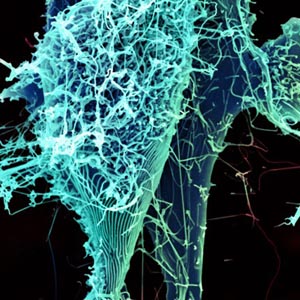Ask Cathy Sheridan what she does for a living, and you’ll get one of two answers: an engineer who oversees design, construction, and other projects for the New York State Thruway Authority and Canal Corporation, or a professional trumpet player who performs solo as well as with large ensembles, national tours of Broadway shows, and legendary singers like Aretha Franklin and Gladys Knight.
Pivoting between two full-time careers suits her just fine. “I do keep them very separate,” says Sheridan (CFA’89). “When I play a show, that’s all I’m thinking about for that three hours, and all of the problems of the day or the previous week are not there, because I have to concentrate on what I’m doing.”
The twin strengths—music and engineering—came early. Sheridan was adept at math and science as a student, and picked up the trumpet in elementary school. (“It was shiny,” she says, “and, certainly for fourth graders, that’s what they’re gravitating to.”) She played through high school and arrived at BU as a trumpet performance major.
“I think most musicians will tell you that trumpet players have an abundance of confidence, sometimes to a fault,” says the outgoing Sheridan, who counts former Tonight Show bandleader Doc Severinsen as an inspiration. “I’m not sure if it’s because you need confidence to play the trumpet, or if the trumpet brings out confidence. There’s really nowhere to hide. Being timid doesn’t produce good results.”
At the College of Fine Arts, Sheridan studied under Roger Voisin, a CFA professor emeritus of music who died in 2008 and who was one of the most influential trumpet players of the 20th century. His words still resonate. “He would say simple phrases, like, ‘Don’t insist.’ To this day, I’m thinking, no, no, don’t insist there.”
She also joined the Army ROTC, intending to enter active service after graduation. But the timing wasn’t right—back then, the Army was undergoing a drawdown—so she joined the reserves instead, serving eight years as a combat engineer and rising to the rank of captain.
Sheridan looks back at her service as a time of transition. She believed she could make a career of music, but would she have to move to New York City or Los Angeles? While she figured it out, she worked as a seasonal construction inspector at the state transportation department in New York.

As deputy chief engineer of the New York State Thruway Authority and Canal Corporation, Cathy Sheridan oversees 160 engineers, geologists, and other professional staff, and a $300 million annual capital program that covers 570 miles of interstate highway, 809 bridges, 11 toll barriers, and 27 travel plazas, as well as 524 miles of canals. Photo by Joseph Capovani
A few years later, she became a permanent employee, earned a master’s in civil engineering and engineering mechanics at Columbia University, and worked her way up. By 2010, she was director of maintenance and operations for the New York State Canal Corporation in Albany, where she oversaw a department of 500 and was responsible for the operation and maintenance of the waterways.
“Anyone who works at the Canal Corporation marvels at its history,” she says. “That history has largely been preserved by the employees, who take great pride in maintaining the structures, most of which are the original design from the early 1900s.”
In its heyday, in 1951, more than five million tons of cargo moved on the four branches of the canal system—the corporation likes to call it America’s first superhighway. Since then, the number has plummeted to an average of 10,000 tons annually as a result of competition from rail, the interstate highway system, and the opening of the Saint Lawrence Seaway. But a rise in fuel prices—the higher they get, the more economical it is to ship by water—can bring a modest resurgence for the system’s tugs and barges. More than 96,000 tons of cargo—corn, soybeans, and other agricultural goods—shipped in 2013.
As is the case with any aging system, maintenance is a big part of the job. “It’s approximately 100 years old,” Sheridan says. “Most of the locks are still running on the original machinery. If something breaks, we have to make it. We have our own machine shops.”
In 2013, Sheridan was promoted to deputy chief engineer of the New York State Thruway Authority, which includes the Canal Corporation. She oversees 160 engineers, geologists, and other professional staff, and a $300 million annual capital program that covers 570 miles of interstate highway, 809 bridges, 11 toll barriers, and 27 travel plazas, as well as 524 miles of canals. If a bridge needs rehabbing or replacement, a section of highway needs repaving or reconstruction, or a canal lock needs repair, Sheridan makes sure it gets done.
After work, she goes back to work. Rehearsals and performances can stretch to 30 to 40 hours a week, depending on the gig. Sheridan, who lives in Greenwich, N.Y., trained as a classical orchestral musician and plays with the Glens Falls Symphony and the Schenectady Symphony Orchestra. But mostly she’s performing in musical theater. “It started with local productions,” she says. “Now, when touring productions come through, I’m called to play, which could be up to eight shows a week plus rehearsals.”
In addition to Aretha Franklin and Gladys Knight, Sheridan has performed with with Kristin Chenoweth, Johnny Mathis, Amy Grant, the Irish Tenors, and Elaine Stritch, and in shows such as Billy Elliot, Hair, Legally Blonde, Miss Saigon, South Pacific, Peter Pan, The Book of Mormon, and Wicked. “It’s fun. It’s a lot of pressure,” she says. “You get four to five hours of rehearsal, and then it’s opening night.”
The pressure is a little like playing the trumpet. “It’s a risk and reward instrument,” Sheridan says. “If I make a mistake, it can be heard in the next county. I guess I like walking that tightrope.”

















































Roger Voisin was indeed one of the great influences in creating the French sound of the Boston Symphony Orchestra under the late great Serge Koussevitzy and le beau Charles Munch. At age of 17 he become Assistant Principal of the orchestra in 1935. His father who himself a member of the trumpet section was against the idea of his son playing in the orchestra but after some negotiations and strong encouragement from Serge Koussevitzy he stayed then in 1950 emerged as Principal. Cathy Sheridan is indeed a fortunate person to have studied with Roger (his son and I played in the Boston Public Schools Symphony Band when we were in high school). A wonderful article!
Great article! Roger Voisin was an outstanding musician and is one of the great influences in giving the Boston Symphony Orchestra its distinctive French sound from the days of Serge Koussevitzy and Charles Munch. Having joined the orchestra as Assistant Trumpet or Principal at the age of 17 in 1935, his father was completely against idea but after some urging from Serge Koussevitzy and even Arthur Fiedler (Fiedler became the conductor of the Boston Pops in 1930 after the not so popular Italian composer Alfredo Casella left the position in 1929). Yes, the sound of the trumpet is truly clarion, bright, a leader in every sense of that word.
Music and science go together more often than one would think. Both my brother and I have multiple degrees in physics, I have an MS in electrical engineering. I am also a violist with a local orchestra, and play and teach piano. My brother was also a physicist, teaching at Purdue University, and played piano (better than I). I have a cousin who was a trumpeter with the New York Symphony, and also did research in physics and chemistry.
I suspect that the brain functions for both are related, requiring logic and flexibility as a minimum. I also suspect that research has been done on this subject, since I doubt if my brother and I are exceptional. It will be interesting t see what other responses you get from this article.